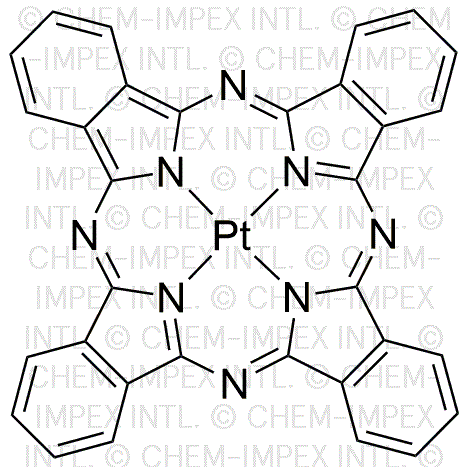Platinum(II) phthalocyanine is widely utilized in research focused on:
- Photodynamic Therapy: This compound is used in medical treatments for cancer, where it helps to generate reactive oxygen species upon light activation, effectively targeting and destroying cancer cells.
- Solar Energy Conversion: In the field of renewable energy, it serves as a photosensitizer in dye-sensitized solar cells, enhancing their efficiency by converting sunlight into electrical energy.
- Electrochemical Sensors: It is employed in the development of sensitive electrochemical sensors for detecting various analytes, including glucose and environmental pollutants, providing rapid and accurate measurements.
- Antibacterial Coatings: The compound is incorporated into coatings for medical devices and surfaces to impart antibacterial properties, reducing the risk of infections in healthcare settings.
- Organic Light Emitting Diodes (OLEDs): It is used in the production of OLEDs, contributing to the development of high-quality displays and lighting solutions with improved color accuracy and energy efficiency.
General Information
Properties
Safety and Regulations
Applications
Platinum(II) phthalocyanine is widely utilized in research focused on:
- Photodynamic Therapy: This compound is used in medical treatments for cancer, where it helps to generate reactive oxygen species upon light activation, effectively targeting and destroying cancer cells.
- Solar Energy Conversion: In the field of renewable energy, it serves as a photosensitizer in dye-sensitized solar cells, enhancing their efficiency by converting sunlight into electrical energy.
- Electrochemical Sensors: It is employed in the development of sensitive electrochemical sensors for detecting various analytes, including glucose and environmental pollutants, providing rapid and accurate measurements.
- Antibacterial Coatings: The compound is incorporated into coatings for medical devices and surfaces to impart antibacterial properties, reducing the risk of infections in healthcare settings.
- Organic Light Emitting Diodes (OLEDs): It is used in the production of OLEDs, contributing to the development of high-quality displays and lighting solutions with improved color accuracy and energy efficiency.
Documents
Safety Data Sheets (SDS)
The SDS provides comprehensive safety information on handling, storage, and disposal of the product.
Product Specification (PS)
The PS provides a comprehensive breakdown of the product’s properties, including chemical composition, physical state, purity, and storage requirements. It also details acceptable quality ranges and the product's intended applications.
Certificates of Analysis (COA)
Search for Certificates of Analysis (COA) by entering the products Lot Number. Lot and Batch Numbers can be found on a product’s label following the words ‘Lot’ or ‘Batch’.
Numéro de catalogue
Numéro de lot/série
Certificates Of Origin (COO)
This COO confirms the country where the product was manufactured, and also details the materials and components used in it and whether it is derived from natural, synthetic, or other specific sources. This certificate may be required for customs, trade, and regulatory compliance.
Numéro de catalogue
Numéro de lot/série
Safety Data Sheets (SDS)
The SDS provides comprehensive safety information on handling, storage, and disposal of the product.
DownloadProduct Specification (PS)
The PS provides a comprehensive breakdown of the product’s properties, including chemical composition, physical state, purity, and storage requirements. It also details acceptable quality ranges and the product's intended applications.
DownloadCertificates of Analysis (COA)
Search for Certificates of Analysis (COA) by entering the products Lot Number. Lot and Batch Numbers can be found on a product’s label following the words ‘Lot’ or ‘Batch’.
Numéro de catalogue
Numéro de lot/série
Certificates Of Origin (COO)
This COO confirms the country where the product was manufactured, and also details the materials and components used in it and whether it is derived from natural, synthetic, or other specific sources. This certificate may be required for customs, trade, and regulatory compliance.


